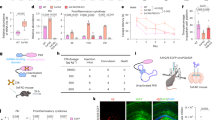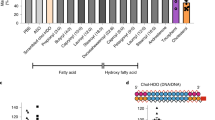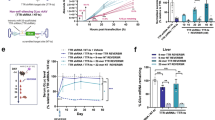Abstract
Therapeutics based on short interfering RNAs (siRNAs) delivered to hepatocytes have been approved, but new delivery solutions are needed to target additional organs. Here we show that conjugation of 2′-O-hexadecyl (C16) to siRNAs enables safe, potent and durable silencing in the central nervous system (CNS), eye and lung in rodents and non-human primates with broad cell type specificity. We show that intrathecally or intracerebroventricularly delivered C16-siRNAs were active across CNS regions and cell types, with sustained RNA interference (RNAi) activity for at least 3 months. Similarly, intravitreal administration to the eye or intranasal administration to the lung resulted in a potent and durable knockdown. The preclinical efficacy of an siRNA targeting the amyloid precursor protein was evaluated through intracerebroventricular dosing in a mouse model of Alzheimer’s disease, resulting in amelioration of physiological and behavioral deficits. Altogether, C16 conjugation of siRNAs has the potential for safe therapeutic silencing of target genes outside the liver with infrequent dosing.
This is a preview of subscription content, access via your institution
Access options
Access Nature and 54 other Nature Portfolio journals
Get Nature+, our best-value online-access subscription
$32.99 / 30 days
cancel any time
Subscribe to this journal
Receive 12 print issues and online access
$259.00 per year
only $21.58 per issue
Buy this article
- Purchase on SpringerLink
- Instant access to full article PDF
Prices may be subject to local taxes which are calculated during checkout






Similar content being viewed by others
Data availability
All datasets generated and analyzed in the study are provided within the manuscript files. Source data are provided with this paper.
References
Setten, R. L., Rossi, J. J. & Han, S. P. The current state and future directions of RNAi-based therapeutics. Nat. Rev. Drug Discov. 18, 421–446 (2019).
Adams, D. et al. Patisiran, an RNAi therapeutic, for hereditary transthyretin amyloidosis. N. Engl. J. Med. 379, 11–21 (2018).
Kristen, A. V. et al. Patisiran, an RNAi therapeutic for the treatment of hereditary transthyretin-mediated amyloidosis. Neurodegener. Dis. Manag. 9, 5–23 (2019).
Balwani, M. et al. Phase 3 trial of RNAi therapeutic givosiran for acute intermittent porphyria. N. Engl. J. Med. 382, 2289–2301 (2020).
Garrelfs, S. F. et al. Lumasiran, an RNAi therapeutic for primary hyperoxaluria type 1. N. Engl. J. Med. 384, 1216–1226 (2021).
Raal, F. J. et al. Inclisiran for the treatment of heterozygous familial hypercholesterolemia. N. Engl. J. Med. 382, 1520–1530 (2020).
Ray, K. K. et al. Inclisiran in patients at high cardiovascular risk with elevated LDL cholesterol. N. Engl. J. Med. 376, 1430–1440 (2017).
Ray, K. K. et al. Two phase 3 trials of inclisiran in patients with elevated LDL cholesterol. N. Engl. J. Med. 382, 1507–1519 (2020).
Foster, D. J. et al. Advanced siRNA designs further improve in vivo performance of GalNAc-siRNA conjugates. Mol. Ther. 26, 708–717 (2018).
Janas, M. M. et al. Selection of GalNAc-conjugated siRNAs with limited off-target-driven rat hepatotoxicity. Nat. Commun. 9, 723 (2018).
Nair, J. K. et al. Impact of enhanced metabolic stability on pharmacokinetics and pharmacodynamics of GalNAc-siRNA conjugates. Nucleic Acids Res. 45, 10969–10977 (2017).
Nair, J. K. et al. Multivalent N-acetylgalactosamine-conjugated siRNA localizes in hepatocytes and elicits robust RNAi-mediated gene silencing. J. Am. Chem. Soc. 136, 16958–16961 (2014).
Alterman, J. F. et al. A divalent siRNA chemical scaffold for potent and sustained modulation of gene expression throughout the central nervous system. Nat. Biotechnol. 37, 884–894 (2019).
Zhou, Y. et al. Blood–brain barrier-penetrating siRNA nanomedicine for Alzheimer’s disease therapy. Sci. Adv. 6, eabc7031 (2020).
Gregory, J. V. et al. Systemic brain tumor delivery of synthetic protein nanoparticles for glioblastoma therapy. Nat. Commun. 11, 5687 (2020).
Eyford, B. A. et al. A nanomule peptide carrier delivers siRNA across the intact blood–brain barrier to attenuate ischemic stroke. Front. Mol. Biosci. 8, 611367 (2021).
Nagata, T. et al. Cholesterol-functionalized DNA/RNA heteroduplexes cross the blood–brain barrier and knock down genes in the rodent CNS. Nat. Biotechnol. 39, 1529–1536 (2021).
Gupta, A., Kafetzis, K. N., Tagalakis, A. D. & Yu-Wai-Man, C. RNA therapeutics in ophthalmology—translation to clinical trials. Exp. Eye Res. 205, 108482 (2021).
DeVincenzo, J. et al. A randomized, double-blind, placebo-controlled study of an RNAi-based therapy directed against respiratory syncytial virus. Proc. Natl Acad. Sci. USA 107, 8800–8805 (2010).
Chappell, A. E. et al. Mechanisms of palmitic acid-conjugated antisense oligonucleotide distribution in mice. Nucleic Acids Res. 48, 4382–4395 (2020).
Chen, Q. et al. Lipophilic siRNAs mediate efficient gene silencing in oligodendrocytes with direct CNS delivery. J. Control. Release 144, 227–232 (2010).
Manoharan, M. Oligonucleotide conjugates as potential antisense drugs with improved uptake, biodistribution, targeted delivery, and mechanism of action. Antisense Nucleic Acid Drug Dev. 12, 103–128 (2002).
Wolfrum, C. et al. Mechanisms and optimization of in vivo delivery of lipophilic siRNAs. Nat. Biotechnol. 25, 1149–1157 (2007).
Schlegel, M. K. et al. Chirality dependent potency enhancement and structural impact of glycol nucleic acid modification on siRNA. J. Am. Chem. Soc. 139, 8537–8546 (2017).
Parmar, R. et al. 5′-(E)-vinylphosphonate: a stable phosphate mimic can improve the RNAi activity of siRNA-GalNAc conjugates. ChemBioChem 17, 985–989 (2016).
Sullivan, J. M. et al. Convective forces increase rostral delivery of intrathecal radiotracers and antisense oligonucleotides in the cynomolgus monkey nervous system. J. Transl. Med. 18, 309 (2020).
Wilcock, D. M. et al. Progression of amyloid pathology to Alzheimer’s disease pathology in an amyloid precursor protein transgenic mouse model by removal of nitric oxide synthase 2. J. Neurosci. 28, 1537–1545 (2008).
Colton, C. A. et al. mNos2 deletion and human NOS2 replacement in Alzheimer disease models. J. Neuropathol. Exp. Neurol. 73, 752–769 (2014).
Kan, M. J. et al. Arginine deprivation and immune suppression in a mouse model of Alzheimer’s disease. J. Neurosci. 35, 5969–5982 (2015).
Hall, H. et al. Magnetic resonance spectroscopic methods for the assessment of metabolic functions in the diseased brain. Curr. Top. Behav. Neurosci. 11, 169–198 (2012).
Su, L. et al. Whole-brain patterns of 1H-magnetic resonance spectroscopy imaging in Alzheimer’s disease and dementia with Lewy bodies. Transl. Psychiatry 6, e877 (2016).
Wang, H. et al. Magnetic resonance spectroscopy in Alzheimer’s disease: systematic review and meta-analysis. J. Alzheimers Dis. 46, 1049–1070 (2015).
Janas, M. M. et al. Safety evaluation of 2′-deoxy-2′-fluoro nucleotides in GalNAc-siRNA conjugates. Nucleic Acids Res. 47, 3306–3320 (2019).
Osborn, M. F. & Khvorova, A. Improving siRNA delivery in vivo through lipid conjugation. Nucleic Acid Ther. 28, 128–136 (2018).
Biscans, A. et al. Diverse lipid conjugates for functional extra-hepatic siRNA delivery in vivo. Nucleic Acids Res. 47, 1082–1096 (2019).
Raouane, M., Desmaele, D., Urbinati, G., Massaad-Massade, L. & Couvreur, P. Lipid conjugated oligonucleotides: a useful strategy for delivery. Bioconjug. Chem. 23, 1091–1104 (2012).
Kubo, T. et al. Palmitic acid-conjugated 21-nucleotide siRNA enhances gene-silencing activity. Mol. Pharm. 8, 2193–2203 (2011).
Byrne, M. et al. Novel hydrophobically modified asymmetric RNAi compounds (sd-rxRNA) demonstrate robust efficacy in the eye. J. Ocul. Pharmacol. Ther. 29, 855–864 (2013).
DiFiglia, M. et al. Therapeutic silencing of mutant huntingtin with siRNA attenuates striatal and cortical neuropathology and behavioral deficits. Proc. Natl Acad. Sci. USA 104, 17204–17209 (2007).
Alterman, J. F. et al. Hydrophobically modified siRNAs silence Huntingtin mRNA in primary neurons and mouse brain. Mol. Ther. Nucleic Acids 4, e266 (2015).
Nikan, M. et al. Docosahexaenoic acid conjugation enhances distribution and safety of siRNA upon local administration in mouse brain. Mol. Ther. Nucleic Acids 5, e344 (2016).
Beaucage, S. L. Solid-phase synthesis of siRNA oligonucleotides. Curr. Opin. Drug Discov. Dev. 11, 203–216 (2008).
Zhang, L., Peritz, A. & Meggers, E. A simple glycol nucleic acid. J. Am. Chem. Soc. 127, 4174–4175 (2005).
Zhang, L., Peritz, A. E., Carroll, P. J. & Meggers, E. Synthesis of glycol nucleic acids. Synthesis 2006, 645–653 (2006).
Schlegel, M. K. & Meggers, E. Improved phosphoramidite building blocks for the synthesis of the simplified nucleic acid GNA. J. Org. Chem. 74, 4615–4618 (2009).
O’Shea, J. et al. An efficient deprotection method for 5′-[O,O-bis(pivaloyloxymethyl)]-(E)-vinylphosphonate containing oligonucleotides. Tetrahedron 74, 6182–6186 (2018).
Kohonen, P. et al. A transcriptomics data-driven gene space accurately predicts liver cytopathology and drug-induced liver injury. Nat. Commun. 8, 15932 (2017).
Davis, J. et al. Early-onset and robust cerebral microvascular accumulation of amyloid β-protein in transgenic mice expressing low levels of a vasculotropic Dutch/Iowa mutant form of amyloid β-protein precursor. J. Biol. Chem. 279, 20296–20306 (2004).
Laubach, V. E., Foley, P. L., Shockey, K. S., Tribble, C. G. & Kron, I. L. Protective roles of nitric oxide and testosterone in endotoxemia: evidence from NOS-2-deficient mice. Am. J. Physiol. 275, H2211–H2218 (1998).
Li, J. et al. Discovery of a novel deaminated metabolite of a single-stranded oligonucleotide in vivo by mass spectrometry. Bioanalysis 11, 1955–1965 (2019).
Liu, J. et al. Oligonucleotide quantification and metabolite profiling by high-resolution and accurate mass spectrometry. Bioanalysis 11, 1967–1980 (2019).
Bolon, B. et al. STP position paper: recommended practices for sampling and processing the nervous system (brain, spinal cord, nerve, and eye) during nonclinical general toxicity studies. Toxicol. Pathol. 41, 1028–1048 (2013).
Acknowledgements
The authors thank Alnylam’s Medicinal Chemistry Team, Medium Scale Synthesis Team, High Throughput Synthesis Team and Duplex Annealing Team for siRNA synthesis. They also thank A. Bisbe, P. Miller and R. Malone for siRNA purification; C. Wong, S. Maczko, M. Mendez, I. Duarte and D. Rooney for in vivo study support; A. Guan for tissue processing; J. Varao for sample management; B. Fitzsimmons for tissue drug concentration analysis; B. Carito, P. Gedman, C.-E. Stephany and K. Bittner for histology support; Alnylam’s Research Analytical Team for metabolic stability studies; and the research team at CRL Finland, especially J. Puolivali and F. Khan.
Author information
Authors and Affiliations
Contributions
K.M.B., J.K.N., M.M.J., S.M., M.K., C.B, D.F., K.F., M.A.M. and V.J. conceived the projects. K.M.B., J.K.N., M.M.J., S.M., Y.I.A.-R., L.T.H.D., H.P., C.S.T., E.C.-R., C.B., D.F., J.K., J.A., A.C., M.K.S., I.Z., M.K., M.A.M. and V.J. contributed to experimental design. L.T.H.D., H.P., C.S.T., E.C.-R., C.B., D.F., J.K., J.A., R.M., J.L., S.M., M.S., T.C., M.J., K.W., J.R., L.W., A.K., D.G., M.W.M., J.P., R.M., T.R., J.B., D.C., S.A., L.J., Y.J., S.L., J.G., T.N., S.C., S.L.B, U.P., A.K., A.B.R. and S.C. contributed experimentally. R.M., J.E.S. and W.D. provided non-human primate evaluations. C.S.T., T.C., K.W., J.R. and L.W. synthesized the duplexes. K.M.B., J.K.N., M.M.J., Y.I.A.-R., L.T.H.D., M.M., K.F., J.-T.W., M.A.M. and V.J. wrote the manuscript.
Corresponding authors
Ethics declarations
Competing interests
All authors are, or were during the time this work was conducted, employees of Alnylam Pharmaceuticals, with salary and stock options.
Peer review
Peer review information
Nature Biotechnology thanks the anonymous reviewers for their contribution to the peer review of this work.
Additional information
Publisher’s note Springer Nature remains neutral with regard to jurisdictional claims in published maps and institutional affiliations.
Extended data
Extended Data Fig. 1 Histopathological evaluation of the nonhuman primate (NHP) spinal cord at three months following a single IT dose of 60 mg C16-siRNA.
Representative H&E (a), LFB (b) and IBA-1 (c) staining of NHP thoracic spinal cord. Microscopic findings in the spinal cord were limited to procedure-related changes (that is, IT bolus administration in lumbar region). These consisted of minimal to mild degeneration of nerve fibers with dilated axonal sheaths and few digestion chambers containing gitter cells (arrowheads) that were localized to the white matter of spinal cord (cervical, thoracic, and lumbar segments). Limited to procedure-affected areas, there were minimal decreases in LFB staining intensity (arrows) and a minimal increase in the number of IBA-1 (brown chromogen) positive microglia (open arrows). Three animals were analyzed per group with similar results. GM = grey matter; WM = white matter.
Extended Data Fig. 2 Histopathological evaluation of the nonhuman primate (NHP) brain at three months following a single IT dose of 60 mg C16-siRNA.
Representative H&E (a), LFB (b) and IBA-1 (c) staining of NHP brainstem (medulla oblongata region adjacent to aqueduct and underlying pons). Microscopic findings in the brain were limited to procedure-related changes (that is, CSF collection from cisterna magna). These consisted of minimal to mild degeneration of nerve fibers with dilated axonal sheaths and few digestion chambers containing gitter cells (arrowheads) that were localized to the peripheral white matter areas. Limited to procedure-affected areas, there were minimal decreases in LFB staining intensity (arrows) and a minimal increase in the number of IBA-1 (purple chromogen) positive microglia (open arrows). Three animals were analyzed per group with similar results.
Extended Data Fig. 3 Histopathological evaluation of the nonhuman primate (NHP) liver at three months following a single IT dose of 60 mg C16-siRNA.
Representative H&E staining of NHP liver (H = hepatocyte; S = sinusoid; KC = Kupffer cell). There were no remarkable microscopic findings. Three animals were analyzed per group with similar results.
Supplementary information
Supplementary Information
Supplementary Tables 1 and 2 and Supplementary Discussion
Source data
Source Data Fig. 1
Statistical Source Data
Source Data Fig. 2
Statistical Source Data
Source Data Fig. 3
Statistical Source Data
Source Data Fig. 4
Statistical Source Data
Source Data Fig. 5
Statistical Source Data
Source Data Fig. 6
Statistical Source Data
Rights and permissions
About this article
Cite this article
Brown, K.M., Nair, J.K., Janas, M.M. et al. Expanding RNAi therapeutics to extrahepatic tissues with lipophilic conjugates. Nat Biotechnol 40, 1500–1508 (2022). https://doi.org/10.1038/s41587-022-01334-x
Received:
Accepted:
Published:
Issue date:
DOI: https://doi.org/10.1038/s41587-022-01334-x
This article is cited by
-
Advances and challenges of targeting epicardial adipose tissue (EAT) and perivascular adipose tissue (PVAT)
Cardiovascular Diabetology (2025)
-
RNA chemistry and therapeutics
Nature Reviews Drug Discovery (2025)
-
RNA Therapies in Cardio-Kidney-Metabolic Syndrome: Advancing Disease Management
Journal of Cardiovascular Translational Research (2025)
-
Molecular Therapeutics in Development to Treat Alzheimer’s Disease
Molecular Diagnosis & Therapy (2025)
-
The Fomivirsen, Patisiran, and Givosiran Odyssey: How the Success Stories May Pave the Way for Future Clinical Translation of Nucleic Acid Drugs
BioDrugs (2025)



